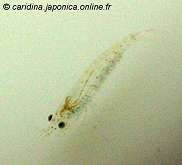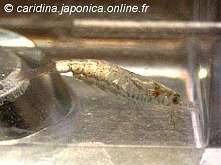Anatomic changes :
Right before matamorphosis, my larvae are less than 1cm long and although they have considerably grown, they haven't changed a lot on both morphologic and behavioral points of view. They still float upside down, barely able to swim, unable to walk on the bottom or walls, and just able to grab their food. Metamorphosis brings some obvious changes on those few points : a metamorphosed juvenile is nothing less than a miniature adult, able to walk, swim forwards in a straight line (and fast), and it is no longer able to float still in the water. The coloration changes too : the larvae are of an orange/reddish color, while the juveniles are greyish and transparent just like adults, though the red/orange coloration can sometimes take a couple days after metamorphosis to completely disappear.
Here is a juvenile mere hours after its metamorphosis (difficult to photograph, because it swims very fast after being disturbed!)
Back to fresh water :
All the zoes do not mutate at the same time and those who haven't mutated yet still need full salinity, so every day from the 25th to the 40th I had to catch the newly metamorphosed juveniles individually in order to "unsalt" them separately.
|
I just sucked them up, one by one, with a pipette (one of those you get in water test kits) with a piece of air tube at its end. The small shrimps are real fast, but thay are not that difficult to catch, once they are sitting still on a wall or the bottom.
|
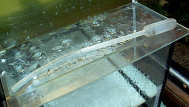
|

|
Getting them back to fresh water is quite simple, I simply put my "catch" of the day in a plastic cup, and every day I change 50% of its water for fresh water. After 3 days there is only 1/8th of seawater left in the cup, and the shrimps contained in it can freely go back in a freshwater tank. Thus I only need 3 cups for that purpose.
|
Once in the main tank, they feed on about the same food as the adults do : organic waste, remnants of uneaten food, etc. They don't need any extra food and still grow incredibly fast !
|
The specimen on this photograph is 58 days old, and is between 10 and 15mm long, so its size has increased by 50% in just a couple of weeks !
|
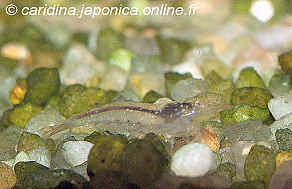
|
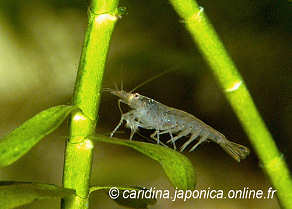
This one, 4 days later, is perched on a bacopa monnieri, which gives a rough idea of its sise.
More photographs of shrimps and juveniles in the Photo Gallery...
